August 11, 2006
Air Date: August 11, 2006
FULL SHOW
SEGMENTS
The Latest in Power Plants
/ Ingrid LobetView the page for this story
By far, the majority of America's electricity comes from burning coal, splitting atoms and burning natural gas. But partly through federal subsidies, renewable energy is getting more commercially competitive. As Living on Earth’s Ingrid Lobet reports, 350 thousand homes in Nevada and California may get their juice from the sun and from hydrogen (05:00)
Killing Endangered Species to Save Them
View the page for this story
Killing animals to preserve a species? That’s the premise of a program designed to sell a limited number of permits to hunters in order to help communities conserve indigenous populations of endangered sheep. Author Daniel Duane went on his first hunt and wrote about it for Mother Jones magazine. He tells host Steve Curwood that after his experience, he had to re-think his notions about hunting. (10:00)
Saving the Bay
/ Andrea KissackView the page for this story
There was a time when the San Francisco Bay was replete with native oysters. But it's been many years now since they were contaminated and fished out. As part of efforts to restore the Bay, Andrea Kissack of KQED reports scientists are trying to bring back these useful and sought-after mollusks. (06:00)
Digging for Owls
/ Jeff RiceView the page for this story
The rare burrowing owl lives underground and has numerous vocalizations, including a call that mimics rattlesnakes to scare off predators. From southern Idaho, producer Jeff Rice reports on his trip with a biologist to dig for the tiny owls (04:30)
Emerging Science Note/Sugar Blues
/ Emily TaylorView the page for this story
Using new MRI technology, researchers have found subtle brain differences in people who suffer from diabetes,which could explain the depression that afflicts so many diabetes patients. Emily Taylor reports. (01:30)
South African Tea Farmers Adapt to Changing Climate
View the page for this story
Rooibos or red bush tea is grown only in the western part of South Africa in an area which has a unique climate and ecosystem. Scientists are working with farmers in a small town in the region to help them adapt their traditional farming practices to climate change. (16:30)
This week's EarthEar selection
listen /
download
Amadiba songs around the campfire
Show Credits and Funders
Show Transcript
HOST: Steve Curwood
GUEST: Dan Duane
REPORTER: Andrea Kissack, Jeff Rice, Ingrid Lobet
SCIENCE NOTE: Emily Taylor
[THEME]
CURWOOD: From NPR - this is Living on Earth.
[THEME]
CURWOOD: I’m Steve Curwood. In the semi-arid region of South Africa known as the Succulent Karoo, farmers are noticing a change in the weather.
MARIETTE: People are talking a lot about they don’t understand the weather any longer and it’s happening later and later that your winter clothes are coming out.
CURWOOD: Seasons of drought have led to failed crops. And scientists predict there could be more dry spells on the way and also extreme rains. In one area, scientists are working with a group of rooibos tea farmers to help them adapt their growing practices to changes in climate.
RHODA: We’re trying to marry the scientific knowledge with the indigenous knowledge, which there is a great body of, and trying to integrate that.
CURWOOD: Also, an owl that has a unique strategy for survival: it lives underground, and sounds like a snake.
[BURROWING OWL SOUND]
CURWOOD: We’ll have these stories and more, this week on Living on Earth. Stick around.
[MUSIC]
ANNOUNCER: Support for Living on Earth comes from the National Science Foundation and Stonyfield Farm.
The Latest in Power Plants
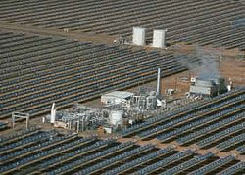
Solar Power Plant (Photo: Solargenix)
CURWOOD: From the Jennifer and Ted Stanley Studios in Somerville, Massachusetts - this is an encore edition of Living on Earth. I’m Steve Curwood. The holy grail of energy production is generating power without pollution. Right now about two thirds of the industrial sulfur dioxide emissions and around 40 percent of the greenhouse gas carbon dioxide gasses produced in the U.S. come from power plants. Clean energy is literally a drop in the bucket: Hydropower generates less than seven percent, solar and wind, just a fraction of that. But as Living on Earth's Ingrid Lobet reports, two new projects in the southwest are generating clean power, and buzz.
LOBET: We've all seen rooftop solar collectors. But there's another kind – industrial strength. It's called concentrating solar. High-tech collectors, like mirrored tanning beds spread over acres of desert land, track the sun across the sky.
MYLES: They operate almost exactly the way a sunflower operates. It wakes up in the morning, facing the east, and tracks to the west.
LOBET: John Myles is president of Solargenics, a North Carolina-based company that's just broken ground on a 350-acre array of concentrating solar collectors in the Nevada desert. With parabolic precision, the mirrors focus heat on a line filled with oil that runs through the center of each unit, heating the oil to 750 degrees Fahrenheit. The hot fluid is then exposed to water flashing it into steam, which drives turbines, just like any other power plant, only you didn't have to burn any coal or gas.
MYLES: Our plant in Nevada is the first plant in 15 years. It's the third largest solar plant ever built in the world and it represents a real resurgence in the industry. We think there will be other projects in Spain very soon, and more plants in the United States.
LOBET: The Nevada One solar project will produce 64 megawatts of power. Small for a power plant, but very large for solar: enough electricity for 50,000 houses. It will need water for it's cooling towers, but so do most power plants that turn heat into electricity. News of most renewable power projects crosses the desk of Jesse Broehl. He edits renewable energy access dot com, and this one caught his eye.
BROEHL: I'd say it's pretty significant. Not just in its size – this is commercial scale solar power – but I think it's also significant in terms of representing a shift for solar, where this new approach, concentrated solar power, has been around for awhile but we haven’t seen a facility like this built in 15 years. So, to see this go up now bodes well for solar in the future.
LOBET: Everyone agrees one big reason this project is being built now is that Nevada requires a quarter of its new green energy to be from solar power.
Not quite as far along on the project table is another new kind of power plant, this one is next to an oil refinery about 20 miles south of downtown Los Angeles. Edison Mission Group and BP are planning to build the world's largest hydrogen-fired power plant. Hydrogen only occurs bound to other substances, and this new plant will get its hydrogen from a waste product known as coke.
PARNELL: It is a black, almost coal-looking substance that is a byproduct of the refining process.
LOBET: Charlie Parnell is Vice President of government affairs for Edison Mission Group. Using coke from the refinery next door will be cleaner than the status quo. Currently, it’s being transported to China, burning heavy ship fuel the whole way.
PARNELL: About 1,000 truckloads a day take the waste petroleum coke from the Carson refining facility to the Long Beach harbor, so we’ll actually have the benefit of no longer using those thousand diesel trucks to deliver that petroleum coke to the harbor.
LOBET: In China the coke is burned. But the part of this hydrogen project that's got energy experts' attention is what BP and Edison plan to do with the remaining waste product, which is carbon dioxide.
PARNELL: The CO2 will be captured after the gasification process. It’ll be put in a pipe and then shipped offsite to existing oil fields where it will be used for further recovery of oil from those fields and it will be sequestered permanently.
LOBET: Oil companies often force gas underground to try to push out thick oil deposits, especially these days, with every barrel worth more than $60. But it's not yet known whether this is an effective way to permanently dispose of the world's surplus carbon. Again, Jesse Broehl.
BROEHL: That's probably one of the things that no one knows about this. How effective is it? Can you just pump gas into the underground? And will it stay there forever? At what point in the future could that be released?
LOBET: That's a question a lot of people would like to see answered. In the meantime, if they can persuade investors, they'll be using refinery waste to produce energy cleaner than natural gas, but dirtier than wind or solar, to serve 300,000 households.
For Living on Earth I’m Ingrid Lobet in Los Angeles.
[MUSIC: Gorillaz "O Green World" from ‘Demon Days’ (Virgin Records – 2005)]
Related links:
- Renewable Energy Access
- Solargenix Energy
- Edison Mission Energy
Killing Endangered Species to Save Them
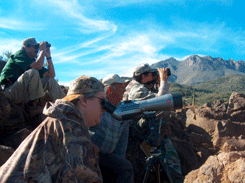
(Photo: Daniel Duane)
CURWOOD: Thirty years ago, it seemed that the magnificent bighorn sheep of the western mountains were headed for extinction. The bighorn is the most prized trophy of the four North American wild sheep species that hunters consider a grand slam. So, the Foundation for North American Wild Sheep came up with a program to save the endangered animals by killing just a few of them. Now, saving an endangered species by hunting them sounds like an oxymoron, but the organization had the notion that by getting a lot of money for a few hunting permits, they could raise money for sheep conservation and community development. The concept seemed unusual to writer Daniel Duane. So, he joined a foundation hunt in Vizcaino Biosphere, in the south of Baja, California, recently and wrote about that experience for Mother Jones magazine.
Dan Duane, welcome to Living on Earth.
DUANE: Thank you.
CURWOOD: Now as I understand it, before you started doing the research for this story, you had never been out hunting. So, what were your views on hunting up until then?
DUANE: Well, I didn’t have very well formed views. I grew up as an urban, liberal environmentalist, with most of my, well, all of my exposure to the outdoors being backpacking in California Sierra Nevada and that sort of thing, and the picture of the hunter, in my mind, wasn’t an especially favorable one. And I think if I had any view of them at all, it came from fairly cliched-notions picked up through TV and here and there. And, I don’t know, visions of beer-swilling guys driving around in pickups trying to blow away Bambi on the weekends and somehow feeling bigger about themselves when they managed to do it.
CURWOOD: So, that’s a pretty negative view, in other words.
DUANE: That’s a pretty negative view. Yeah.
CURWOOD: So, for this story, you end up going out on a trip with a man named Brian Drettmann. He’s a wealthy man who’s a seasoned hunter from Michigan and as I understand it, he’s paid $59,000 at an auction for a permit for, basically, for the right to hunt bighorn sheep which are considered endangered. But, how does this work?
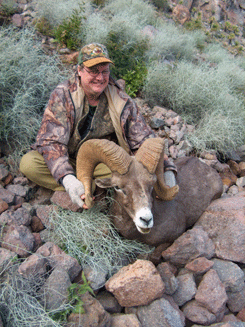
Hunter Brian Drettmann paid $59,000 for the right to hunt this bighorn ram.
(Photo: Daniel Duane)
The killing of the endangered Bighorn sheep over the last 15 years through these FNAW permit programs has raised many, many millions of dollars for the conservation of those sheep and has been directly responsible for, I believe, it’s a four-fold increase in the number of wild sheep in North America.
CURWOOD: So, tell me about the hunt itself. What happened? You get up in the morning, and?
DUANE: Well, we get up before dawn. We load up our packs, you know, have breakfast around a fire, load up our packs and start up the mountain. The guides took us up sort of winding, snaking, very steep footpaths. At times we were scrambling on hands and feet. We gained a couple thousand feet elevation to get to a ridge near the summit of the mountain that would allow us to look down into the canyon where the sheep were, moving as quietly as possible and whispering and being careful not to drop anything or brush any sticks. We crept up to the edge there and looked over and down at the sheep. It took a while for Ramon the chief guide to figure out exactly which ram he wanted Brian to shoot.
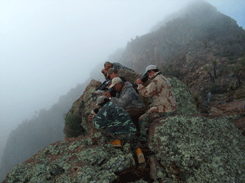
High atop Mexico’s Tres Virgines volcano, hunter Brian Drettmann takes aim at a bighorn ram as guides uses binoculars and range finders to tell him which animal to shoot.(Photo: Daniel Duane)
CURWOOD: What was he looking for?
DUANE: He was looking for the oldest ram and the ram with the largest rack of horns.
CURWOOD: And, why is that good?
DUANE: That’s good for hunters because hunters like big racks of horns. And, it’s good for conservation because the oldest ram in the group has presumably had plenty of opportunity to spread his genetic diversity through the herd. So, Ramon eventually pointed to a particular ram down near a Yucca tree. There was a lot of anxious whispering back and forth between Brian and Ramon to make sure that Brian knew exactly which ram Roman had in mind. Once Brian was confident, he chambered a bullet in his rifle and settled his crosshairs on that ram and waited for the all clear. For a moment there was a ewe, a female Bighorn, standing directly behind the ram. So, there was some concern that the bullet could go through the ram and kill the ewe as well.
CURWOOD: What would happen if you killed the wrong ram or the ewe?
DUANE: It would have put a real smear on the hunt. It would have been very upsetting for everybody involved. The Ajiditarios are very committed to preserving their sheep. They place an enormous value on preserving their herd and a killed female is a small catastrophe for them. There also was a Mexican government game warden along, whose job was precisely to make sure that no mistakes of that kind were made. So it’s my sense that there would have been a great deal of paper work to do, and explanations to be made. It would have cast a real shadow over Drepman’s experience, for sure.
CURWOOD: So what happens next?
DUANE: What happens next is that finally that ewe moves, Ramon, the guide, hisses "listo," all clear, and, there’s a dead silence in the group for a beat and then this tremendous concussion as Brian pulls the trigger and the rifle bucks. The sheep had all sort of bolted; they had no idea what had happened, but of course they ‘d heard this terrifying noise. And, then came this groan sort of as Ramon was communicating that Brian had missed.
CURWOOD: We’re speaking with Daniel Duane about hunting endangered sheep in a bid to conserve them. We’ll join him back on the bighorn trail in just a minute.
[MUSIC: Tom Verlaine "Spiritual" from ‘Warm and Cool’ (Thrill Jockey – 2005)]
CURWOOD: Keep listening to Living on Earth.
[MUSIC: Roots Tonic "Instrument of the Trinity" from ‘Meets Bill Laswell’ (ROIR – 2006)]
CURWOOD: It’s Living on Earth. I’m Steve Curwood. We're back with Dan Duane who's telling us the story of his first hunt – a hunt that's sponsored by the Foundation for North American Wild Sheep, part of a program that allows hunting of the endangered sheep in order to conserve them. Our story continues as hunter Brian Drettmann, who had paid almost $60,000 for a permit to bag a bighorn sheep, has taken a shot and missed.
DUANE: Part of the problem had been that the range finder wasn’t working when Brian took that shot and he wasn’t sure how far away the sheep was. After that first shot missed, suddenly the range finder started working again and Brian got a clear view of his sheep. He got a clear read that it was 150 yards away. As he took the second shot, he did what I’m told a good hunter tries his best to do which is to let out a long, steady exhale as he squeezes the trigger. This time a cry went up among the guides that he had hit the target.
CURWOOD: And how did you feel?
DUANE: I was surprised to feel exhilarated by it. I had wondered what I would feel in that moment. I had really wondered in advance what I would feel watching a man shoot a Bighorn ram. Growing up in California and spending time in the mountains of California, the Bighorn had always loomed for me as the real sort of mystical inhabitants of the airy keeps of the high mountains. And, I wondered if I was going to feel revolted or saddened or something like that and I didn’t at all. I felt exhilarated by it. I felt excited by the adventure of it. I felt privileged to be along with these local men and watching them apply their woodcraft, their tracking and all of that. Another thought I had was, you know, please let me go this way. This guy was, he was near his expected life span anyway. He was in great health. He was eating from his favorite kind of bush. He was surrounded by all his descendants and family. And then the lights went out.
CURWOOD: So, how do you think your views on hunting changed after this hunt?
DUANE: Ray Lee, the CEO and president of the Foundation for North American Wild Sheep said to me that, in defending hunting, he said to me that, look this is the way people did it for tens of thousands of years. This is how people got food and now we all get our food wrapped in cellophane at the supermarket. And, if you ask a hunter what he’s doing out there, he’ll tell you: "Look, 362 days a year I get my food wrapped in cellophane and three days, on these three days a year when I go hunting, what I’m doing is putting myself back in, putting myself back into the natural world." And, as someone whose idea of being put back in the natural world has typically meant finding a gorgeous high mountain lake and watching the sunset, it was hard for me to accept the blood sport version of being put back in the natural world, until I was out on the mountain with that sheep, watching it being butchered and then eating it. I felt privileged to be there and I did feel that at least in the one setting in which I participated, hunting could really be an extraordinary way to participate in the rhythms of life.
CURWOOD: How do you feel about going hunting again, yourself?
DUANE: Well, I’m curious about it, you know. I was so enthusiastic about this that Brian has invited me to go turkey hunting with him in Michigan this spring and I’m really looking forward to it. I’m curious about it, you know, I mean, again I’m not sure what it’s going to feel like because I’ll be taking yet another step to actually pull the trigger. But, I plan to have a big dinner party afterwards and, you know, have roast wild turkey for a bunch of friends and learn some good recipes for stuffing, I guess.
CURWOOD: Daniel Duane is the author of the article, "Sacrificial Ram," in the March/April issue of Mother Jones magazine. Thanks so much for taking this time with me today.
DUANE: Thanks for having me.
Related links:
- Foundation for North American Wild Sheep
- "Sacrificial Ram" by Daniel Duane in Mother Jones
CURWOOD: And, if you have an opinion about hunting in the name of conservation, we’d like to hear from you. Our telephone number is 1-800-218-9988. That’s 800-218-9988. And you can reach us at comments at loe dot o-r-g; once again, comments at loe dot org. Our postal address is 20 Holland Street, Somerville MA, 02144. And you can call our listener line at 800-218-9988. That’s 800-218-9988. CD’s and transcripts are fifteen dollars.
[MUSIC: Tom Verlaine "Spiritual" from ‘Warm and Cool’ (Thrill Jockey – 2005)]
Saving the Bay
CURWOOD: San Francisco Bay is one of the world's most popular places. But that popularity has come with a cost: gold mining runoff, dredging and development have killed many native species that once thrived in the Bay. Now an ambitious plan is under way to restore it to its natural state. And one critical step is to bring back a tiny, native shellfish. Andrea Kissack has more.
[OYSTERS BEING SHUCKED AND SLURPED DOWN]
KISSACK: The lunch crowd at Hog Island Oyster Company on the famous San Francisco wharf slurps down oysters just as fast as the waiters can shuck ‘em. But these oysters didn’t come from the bay, just a few feet away. They were hauled down from another body of water, 60 miles north--Tomales Bay. There was a time when you could eat native oysters right out of San Francisco Bay. For generations the mollusks fed the Coast Miwok and Ohlone Indians.
[PIANO MUSIC]
KISSACK: In the late 1800s, it was the gold miners' voracious appetite for the native Olympic oyster that made the Bay Area the capital of the west coast oyster industry. Jack London even memorialized the abundant oyster in his short stories. But by the time of London's death in 1916, San Francisco oysters were mostly gone, choked off by the city’s raw sewage or over-fished. The oysters that survived were imported from Seattle or hauled by train from the East Coast and dumped on top of the old San Francisco oyster beds. But by the 1940s, even the non-native oysters couldn’t survive in San Francisco’s increasingly polluted bay.
[SOUND OF SLOSHING WATER]
MCGOWAN: Well, the last time I tried this I sank to about my knees walking through this mud.
KISSACK: In the shallow waters off Tiburon, in the northern part of the bay, Marine biologist Mike McGowan sloshes through four feet of quicksand-like sludge, washed down from upstream.
MCGOWAN: This mud, which is a legacy of the hydraulic mining, gold mining in the Sierras is still here in the bay.
[SOUND OF WADING IN WATER]
KISSACK: McGowan is trying to find one of his oyster beds. Last spring, volunteers helped him sink clusters of empty oyster shells off this shore in hopes they would become homes for baby oysters. A larger scale effort is succeeding in Chesapeake Bay. But while that experiment aims to revive the eastern oyster industry, McGowan hopes to save San Francisco Bay, and bringing back the oyster may be the key.
MCGOWAN: Everything is interrelated. The oysters help the eel grass, the eelgrass helps the oysters. Having more oysters and eelgrass means that there’s more habitat and shelter for fish.
KISSACK: When the whole bay ecology improves, crabs, starfish and birds benefit too. Oysters are also the lungs of the bay. Just one can filter more than 15 gallons of water a day, enough to nearly fill a bathtub. So, more oysters mean cleaner water and more life in the bay.
MCGOWAN: The first thing we are going to do is walk out to that oyster reef. Turn it upside down.
KISSACK: It’s low tide on a sunny Thursday morning and McGowan is slogging through the mud flats to reach one of several white buoys. This one is floating about 40-feet off shore. Anchored to the buoy is a sunken wooden pallet with about a dozen nylon mesh bags stacked and tied together. The bags are full of oyster shells. When they are very young, oysters are searching for something hard, to cement themselves.
MCGOWAN: They will recruit onto just about anything--wood, old batteries’ cases, shopping carts, but they greatly prefer other oyster shell because a good place to land for a young oyster is where adult oysters have already managed to grow up and survive.
KISSACK: When they find a home, oysters stick to it for life. They are much more adventuresome when it comes to their sex lives. Oysters are hermaphrodites, beginning life as males but changing to females to spawn hundreds of thousands of larvae. And back and forth they go, spending the rest of their lives switching genders. Meanwhile the pin-head sized oyster larvae are carried by the currents of the bay. And McGowan is, well, hoping to catch their drift. While some of his early tries failed, today he finds what he's looking for.
MCGOWAN: Ok, now here's an oyster, this is really great. I have looked at three shells and Brooke, how many have you looked at? Four? OK, so seven shells, on the eighth shell we found a large, native oyster, oh, there's another one.
KISSACK: McGowan searches 100 shells and finds 23 baby oysters. With the help of volunteers from the Tiburon Audubon Center, he carries them to shore and measures each one.
MCGOWAN: 2.5 centimeters.
KISSACK: At two months old, these oysters are just beginning to grow their own shells, inside the ones they’ve found. It's the way they've been doing it for millennia. This is one of several projects funded by the National Oceanic and Atmospheric Administration. McGowan, the Tiburon Audubon Center and local conservation groups are counting on the resilience of nature to bring back the oysters.
MCGOWAN: One way to look at it is that each isolated, small population of oysters is like a little light bulb. When the larvae from one population find a good place and settle, that’s like a light bulb turning on, but then one of these light bulbs is turning off some place else. So what we’d like to do is have enough light bulbs blinking on and off around the bay that it’s a continuos glow and the oyster population makes a comeback and does it on its own.
KISSACK: McGowan is hoping that happens in his lifetime. And if the bay’s native oyster does return, we may find that sometimes we can reverse some of the damage we’ve caused. For Living on Earth, I’m Andrea Kissack in San Francisco.
[WADING IN THE WATER]
[MUSIC]
Digging for Owls
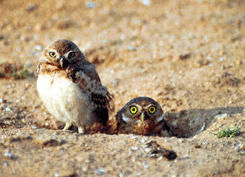
CURWOOD: Time now for a quiz. Owls live in A – trees; B – underground; C – both of the above. The correct answer is C. There is one species of owl, the burrowing owl, who prefers the underground. And that has led to some other unusual adaptations.
From Idaho, Jeff Rice has our report.
RICE: It's well over a hundred degrees out on the Snake River plain in southern Idaho and biologist Jim Belthoff is digging for owls.
[SOUND OF DIGGING]
RICE: This is a study site on the Snake River Birds of Prey National Conservation Area a few dozen miles from Boise. The vast expanse of tan colored soil and sagebrush has one of the densest populations of nesting raptors in North America. Today, we're hoping to find some rare burrowing owls.
[DIGGING]
BELTHOFF: The owls will be down here in this chamber...
RICE: Western burrowing owls are one of the smallest owl species and live in abandoned ground squirrel or badger holes in wide open areas like this one.
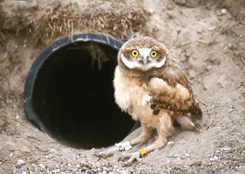
A baby burrowing owl and the entrance to its plastic burrow. (Photo: Dr. Jim Belthoff)
RICE: The field is next to a highway and seems barren. Mostly clay soil and hardly even any grass. Exactly the way the owls like it.
BELTHOFF: They like areas with very little vegetation. Little or none actually is what they prefer. And the reasoning is that they like no vegetation so that they can see any ground dwelling predators approaching their nest so they can get out of the way.
RICE: It's a strategy that works.
[OWL CALL]
RICE: A tiny brown and white adult owl no more than ten inches tall spots us. He rises up on a pair of spindly legs, sounding a warning call.
[SOUND OF CALL; DIGGING]
RICE: The rest of the owls are hunkered down, but we know right where to dig. Belthoff, a professor at Boise State University, has built some artificial plastic burrows. The owls have moved in and Belthoff can dig down to the lid and open the den up without too much trouble.
BELTHOFF: Some footprints in front of this one, so we'll probably find some babies in here.
RICE: Belthoff reaches his hand into the den to retrieve a bird and…suddenly…
[SOUND OF SNAKE RATTLE]
RICE: The sound is coming from inside the hole.
[RATTLING]
RICE: We know that this area is crowded with rattlesnakes, but Belthoff doesn't jump back. He reaches deeper into the hole, blindly feeling around.
[RATTLING]
RICE: He grabs something, coming out with a burrowing owl fledgling. The bird is about a month old. Its mouth is open and it is hissing at us.
[RATTLING]
BELTHOFF: Burrowing owls have about 17 documented types of vocalizations, of which this rattle call or hiss is one of them.
RICE: It's uncanny. Belthoff explains that it's something that only the juvenile owls will do. They haven't developed their ability to fly yet, so they need another way to ward off predators.
BELTHOFF: It's a case of what's called "mimicry" in animals in where either the site of something or the sound of something sounds like something else and, in this particular case, it's a case of Batesian mimicry where the sound of something that's harmless actually mimics something that's harmful.
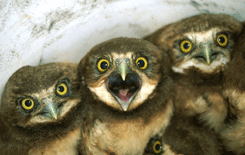
A baby owl chick vocalizes. (Photo: Dr. Jim Belthoff)
BELTHOFF: There's a lot of rattlesnakes in holes and so any potential predator that's coming up on this hole and sneaking down the tunnel would actually think twice, perhaps, if he hears a rattlesnake in there. Certainly, I feel some trepidation when I reach my arm down in there and I hear those rattles, and I'm hoping it's not a rattlesnake.
[RATTLING]
RICE: The owl's mimicry is effective against predators like badgers, but it can't protect it from its biggest threat, bulldozers and creeping human sprawl. Burrowing owls are considered threatened or endangered in a number of western states. The owls tend to live on wide-open flat ground, a perfect place for shopping malls and parking lots.
[PASSING CAR]
RICE: That's why Belthoff is monitoring the birds, keeping track of their health and weight and tagging them to study their migration patterns.
BELTHOFF: We band each one with an aluminum leg band, and then we give them three color bands, so when they sit up on a perch we can actually read those colorband combinations with a spotting scope. And we can tell who it is we're dealing with without having to capture them.

Burrowing owl chicks in a bucket. (Photo: Dr. Jim Belthoff)
[DIGGING]
RICE: After the young birds are tagged, we cover up the owl den. An adult owl has been watching us from a fence post, probably the whole time, its call a bit less fearsome above ground.
[CHIRPING]
RICE: For Living on Earth, I'm Jeff Rice in southern Idaho.
[MUSIC: The Mighty Echoes "The Great Pretender" from ‘Doo Wop Til You Drop’ (Memphis International Records - 2003)]
Related links:
- Burrowing Owl (Cornell Lab of Ornithology)
- Dr. Jim Belthoff’s website
Emerging Science Note/Sugar Blues
CURWOOD: Coming up: monitoring the effects of climate change on rooibos tea plants in South Africa. First, this Note on Emerging Science from Emily Taylor.
TAYLOR: Feeling sweet, but a little low? Scientists working in conjunction with the Joslin Diabetes Center have new evidence that some people living with Type 1 diabetes have subtle differences in parts of their brain which, down the road, may be responsible for depression in diabetes patients.
Using a new three-dimensional form of magnetic resonance imaging called voxel-based morphometry, or VBM, scientists were able to take very sensitive measurements of small areas of the brain. What they found was a lower density of gray matter in certain areas of the brains of the diabetes patients. They were also able to associate this less-dense area with inferior glycemic control.
Although no changes were found in processing functions, the researchers believe that similar brain damage, caused by diabetes, may be responsible for the common depression among diabetes sufferers who suffer from depression at twice the rate of the general public.
Depression in diabetes patients was originally attributed to the increased stresses found among people living with the disease. The VBM technology may be able to prove that it's the result of actual brain damage from diabetes and just may help explain those "sugar lows." That's this week's Note on Emerging Science, I'm Emily Taylor.
CURWOOD: And you’re listening to Living On Earth.
ANNOUNCER: Support for NPR comes from NPR stations and: The Charles Stewart Mott Foundation, online at M-O-T-T dot org; supporting efforts to promote a just, equitable and sustainable society; The Kresge Foundation, investing in nonprofits to help them catalyze growth, connect to stakeholders, and challenge greater support. On the web at Kresge dot org; and , the Kellog Foundation, helping people help themselves by investing in children, their families, and their communities. On the web at W-K-K-F dot org; This is NPR, National Public Radio.
[MUSIC: Roots Tonic "Employees Must Wash Your Hands" from ‘Meets Bill Laswell’ (ROIR – 2006)]
South African Tea Farmers Adapt to Changing Climate
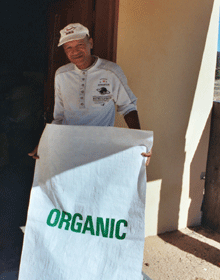
Rooibos tea farmer Koos Koopman holds up one of the bags the collective uses to ship Fair Trade organic rooibos tea. (Photo: Eileen Bolinsky)
CURWOOD: It’s Living on Earth. I’m Steve Curwood. It’s daybreak in the far southwestern corner of Africa, a few hours drive north of the Cape of Good
VAN WYK: When they see the bakkie or the pickup coming they all run to that because they know it's food. In the commotion every mother loses her lamb. Every morning you will find 20, maybe less, hopefully less, sheep or little lambs dead around there … And the first time my husband took me out with him I felt like crawling under the bed when I came back. I just couldn't handle all those little dead bodies lying there.
If we have good rains for the next two years we hope to recover, in about two to three years.
CURWOOD: So let me ask you this: How much does it seem that the weather is outside the normal range of what it seems to have been all the years that your family has been farming here?
VAN WYK: Umm, I am always careful to say this: people are talking a lot about they don't understand the weather any longer. And it's happening later and later that your winter clothes are coming out.
[BUMPING TRUCK]
CURWOOD: On the road along the front of the Suid Bokkeveld Mountains into the town center of Nieuwoudtville, rows of cultivated rooibos look dusty and dry in the heat of what locals say should be a cool early winter day. Signs that this could be more than just the odd dry spell have attracted the interest of scientists at the Climate Systems Analysis Group at the University of Cape Town.
The science involved is complicated, but the general scientific consensus is that the earth is warming because of the widespread burning of coal, oil and gas since the Industrial Revolution, as well as the cutting of vast amounts of forests. The El Niño weather pattern that seems to come more and more often with this warming tends to parch this corner of the planet.
ARCHER: One of the climate change projections is that there will be kind of a longer term drying out, or a reduction, for the broader area. Not just for the Suid Bokkeveld but for interior South Africa.
CURWOOD: Dr. Emma Archer is a geographer with the Climate Systems Analysis Group.
ARCHER: A second one, which is quite worrying, is that there may be an increase in the frequency in what we call dry spells. So a period without rain, which is critical for agriculture within a rainy season, we may be getting more of those. And, most importantly, the broad projection, and something which the World Meteorological Organization actually put out a brief last year on which they agreed. Whereas people may have been receiving rainfall within a certain range, around a normal value, it seems as though that variability will increase. And so more extreme precipitation events will be experienced.
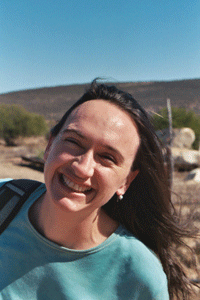
Dr. Emma Archer (Photo: Steve Curwood)
[GENTLE WIND]
CURWOOD: A few years ago a group of rooibos farmers in the Nieuwoudtville area organized themselves into the Heiveld Cooperative, with the help of the Environmental Monitoring Group, an advocacy agency. To boost income, they got their crop certified as organic and developed markets in Europe where the reputed health benefits of rooibos are prized. They are also working on strategies to cope with the effects of long term-drought. Noel Oettle is program manager for the Monitoring Group.
OETTLE: The farmers are quite aware that the climate is getting tougher. That's their perception and the data is certainly supporting a trend towards drier and more extreme climatic events. And there are a number of ways in which they can adapt their practice towards production which is less likely to be affected by climate.
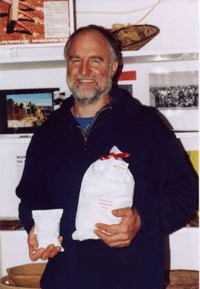
Noel Oettle of the Environmental Monitoring Group
(Photo: Eileen Bolinsky)
LOUW: We’re looking at the sustainable harvesting of Rooibos wild tea….
CURWOOD: …which is relatively slow growing. But Rhoda is looking to see if farmers could gather enough of it to make it economically worthwhile.
LOUW: And we’re looking particularly at the wild rooibos tea because it’s a strong source of income for the people in the Suid Bokkeveld.
CURWOOD: There could be advantages. The cultivated tea that farmers use now can be harvested every year, but it has to be replanted every few years at considerable expense. The wild variety only needs to be carefully harvested by hand where it is found, although it can only be cut every two years.
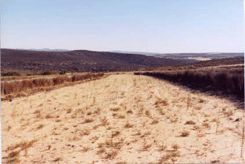
A cultivated rooibos field, after harvest.
(Photo: Eileen Bolinsky)
[TEA POURED, DOG BARKS IN BACKGROUND, TEA POT SET ON TABLE]
LOUW: Would you like some sugar with your tea?
CURWOOD: Oh, no thank you, just a little bit of milk.
[CLINKING]
CURWOOD: If wild rooibos tea is to be successfully marketed, it will need to stand up to the flavor of the popular cultivated rooibos. So Noel, Rhoda and Emma give me a taste test.
CURWOOD: Okay. (SIPS AGAIN) Mmmm, mmmm, this is good (SETS DOWN CUP), this is outstanding.
OETTLE: Steve, you get our "wildman from the North" award (LAUGHTER).
CURWOOD: The cultivated tea is delicious and the wild rooibos tastes great, with a sweet aftertaste like honey.
[KOOPMAN CALLING AND FEEDING SHEEP]
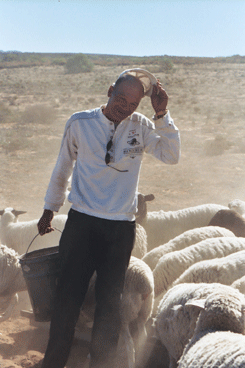
Koos Koopman and his sheep (Photo: Steve Curwood)
Like other parts of South Africa, there are many plants here found nowhere else in the world. Though with its biting winters and scorching summers, the semi-arid Karoo has a radically different climate from much of the rest of the country. Its unique location and size have attracted scientists looking for evidence of the local impact of global climate change.
[TRACTOR ENGINE]
CURWOOD: Farmers here grow grain like oats and barley, and raise sheep. This is also the only place where the famous South African rooibos, or red bush, tea grows. This woody shrub looks much like the many other fynbos bushes, although a closer look reveals shiny dark green leaves shaped much like the herb rosemary.
Traditionally, the Khoisan, or Bushmen, brewed a bright reddish-orange tea from the rooibos leaves. Now, thanks to the smooth taste of the tea and its reputation as a promoter of health, the cultivation of rooibos is the biggest cash crop for many farmers here, including Koos Koopman.
[TRACTOR STOPS]
KOOPMAN: I grow Rooibus tea. And then I make a little bit of small fruits, a little bit of vegetables in the garden like potatoes, carrots, cabbages, oranges, guavas. I don’t plant vegetables for marketing. I want to do it, but I haven’t got enough money yet to do that.
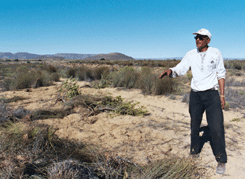
Farmer Koos Koopman in his rooibos tea fields.(Photo: Eileen Bolinsky)
KOOPMAN: I was always thinking of this farm. And so about two years back, I come here one day and he tell me that they got problems. As we sit here in front of the house he ask me, Koos, I want to sell this farm now and I want you to buy this farm.
CURWOOD: So, you’re all in this together, this is a family farm?
KOOPMAN: It’s a family farm. Can we go to there? I want to see my pot quickly. I was busy to make some soup for us, for lunchtime.
[FOOTSTEPS]
KOOPMAN (WALKING): You know that’s the way I grow up, with my pots on the outside. We bake our own bread, we make everything for ourselves, you know, we try to purchase as little as possible from the shops. And that’s the only way you can survive on the farm.
[SOUNDS OF BUBBLING SOUP, STIRRING]
CURWOOD: Saving money is especially important when you have a new and high mortgage on your farm. And during the drought of 2003 things were very difficult for Koos -- 40 to 70 percent of his rooibos plantings withered and died. Cultivated rooibos is his biggest source of cash but there was a tiny bright spot: during the drought the wild rooibos plants scattered among the brush on his land seemed to hold their own.
Like every farmer, Koos knows there can be bad years, but he does feel that the seasons are becoming less predictable. I asked him how they are changing.
KOOPMAN: Sometimes very hot. Sometimes very cold. I’m not talking about the rain. Cold, and then snow, like a little snow, and it is dry and it burns the plants. And some of the things…when it is wet and the rain fall and it is very cold in the evening, and during the day it gets very hot.
[BLEATING LAMBS AND SHEEP]
CURWOOD: A few kilometers closer to town in Nieuwoudtville, the family of Mariette and Willem van Wyk has been farming for six generations since their ancestors came from the Netherlands.
[TEA BEING POURED]
CURWOOD: Mariette van Wyk pours me a cup of the naturally caffeine-free rooibos tea, and tells me that their operation has also been hit hard by the drought of 2003.
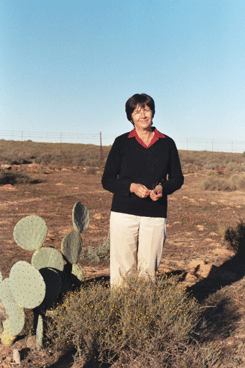
Mariette van Wyk (Photo: Eileen Bolinsky)
CURWOOD: Usually they harvest 40 tons of rooibos in a year. In 2003, 80 percent of the crop failed. And when it became clear that the magnificent display of spring flowers was also not going to happen, it meant the tourists didn’t come to the bed and breakfast the van Wyks have run for almost two decades.
And with nothing growing for forage they could not afford much in the way of rations for their flock of 2,000 sheep. Parsing out what little grain they did have to the sheep and recently born lambs proved to be a heartbreaker for Mariette.
CURWOOD: We’re back on the farm of Koos Koopman to see the wild rooibos tea plants that Rhoda Louw is studying. But before we head for the fields, Koos stops to tend his flock of sheep.
In case of drought, Koos says he’s careful to limit the size of his flock. He wouldn’t want them to overgraze and clean out his wild rooibos. He’d like to sell their meat as organic, but he hasn’t found a market yet. Still, he foregoes hormones and antibiotics in favor of traditional herbs to treat any illnesses in the flock. As we wait to drive to the fields, botanist Rhoda Louw explains how she’ll use the data she’s gathering at the Koopman Farm.
LOUW: We’re trying to marry the scientific knowledge with the indigenous knowledge, which there is a great body of, and try to integrate that. The final product will not be just the thesis, but also a harvesting manual that will come out of the research based on the results.
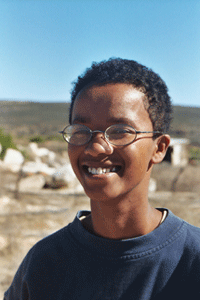
Rhoda Louw (Photo: Steve Curwood)
LOUW: One of the research questions is what is the difference between the wild tea and the cultivator. To measure that, we are looking at the life cycles of the two and comparing them over time. Another experiment is we are trying to see which harvest season gives you the greatest re-growth after a year.
[CAR DOOR SHUT, DRIVES AWAY]
CURWOOD: Climate researcher Emma Archer, Koos and Rhoda point out some planted tea fields and various soil conditions on our way to the wild rooibos. And Rhoda does a bit of translating as Koos slips into Afrikaans.
[KOOS SPEAKING IN AFRIKAANS]
LOUW TRANSLATING: This is cultivated tea on both sides. This tea is about six years old. And if you look at this patch over here on my left, you’re going to get more moisture here than down below.
ARCHER: Koos is saying there is more rainfall here because it’s higher, and you can see that.
CURWOOD: But it’s out of the vehicle to see the wild tea, and more than just a short hike.
LOUW: I’m going to take you to some of the sites, to some of the samples within the experiment here.
[FOOTSTEPS]
CURWOOD: Rhoda has about 250 plants in her experiment. The tea bush branches are cut off by hand with a sickle, leaving enough behind so it can keep growing. Farmers already know that the planted or cultivated rooibos might produce for less than a decade. The wild bushes have a longer productive life and can grow to be fifty years old. The wild tea is also more resistant to pests than its cultivated cousin, although the same pests go after both.
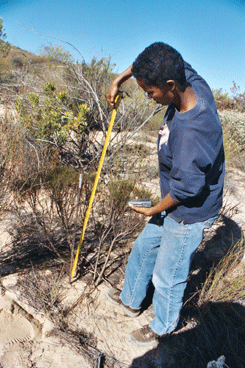
Rhoda Louw measures a rooibos bush.
(Photo: Steve Curwood)
CURWOOD: Can you move wild rooibos, veld rooibis? Can you move the plant and replant it?
KOOPMAN: That is something I experimenting at the moment. I’m busy with it, me and Rhoda, but it don’t work.
[FOOTSTEPS]
CURWOOD: As we walk through the brush to find the experimental plants, we see one that was harvested the previous year in April, during the drought, and it’s almost dead. Others fared a bit better. And then we come upon a particularly robust rooibos plant, and Rhoda flashes a big smile.
LOUW: This is the July, one of the samples harvested in July.
CURWOOD: So, this is your more successful one from last year?
LOUW: From what I’m seeing, this is the most successful.
CURWOOD: What is the traditional time to cut this?
KOOPMAN: The traditional time is anytime from February to April. But look at those ones that were cut in January, February and into March. The experiments of that and the growing of that are much slower than the one of July. So, this is something that I’m working on. Maybe. But there’s one thing: you can’t dry the tea in July month because it needs sun and it is our rainy season, July. And we need sun, no rain when we harvest the tea and make the tea.
[WIND]
LOUW: So the production factors play a role in when tea gets harvested conventionally. But the tea, from what I’m seeing the tea is responding to rain events, not season patterns but rain patterns.
[FOOTSTEPS UP AND UNDER]
CURWOOD: As we leave the experimental plot, the ironies sink in. Wild tea is more resilient than cultivated tea, but it does its best when it is harvested during the rainy season -- yet traditional methods of curing the tea must be used when there is no chance of rain.
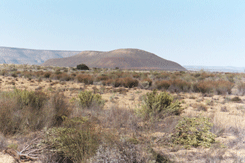
Windbreaks help prevent soil erosion.
(Photo: Eileen Bolinsky)
[TRUCK DRIVING]
CURWOOD: Meanwhile, Koos is working toward a future that he hopes he can pass on to his children. And he’s confident with his experience and faith and the findings of the researchers, he’ll find a way to survive.
KOOPMAN: And we pray for the rain. Come and see me in five years time.
CURWOOD: What happens if it doesn’t rain?
KOOPMAN: Ah, I will never say that it won’t rain. It will rain. God makes summer, winter, spring and everything. You know, that’s one thing that a farmer must have. He must never lose hope.
CURWOOD: The rains finally did come this spring, two years after we first reported this story. Noel Oettle of the Environmental Monitoring Group reports that, despite the past few years of drought, Koos and the Heiveld Co-operative managed to maintain production, though at reduced levels. This year the Co-op produced 32 tons of rooibos tea, mostly for export to Europe and North America.
[SINGING]
Related link:
Environmental Monitoring Group
CURWOOD: We leave you this week in the eastern part of South Africa, on the Wild Coast.
[EARTH EAR: The Amadiba Adventures" singing recorded by Eileen Bolinsky on the Wild Coast, Eastern South Africa (May 2004)]
CURWOOD: Members of the eco-tourism project called Amadiba Adventures share their music and dances with visitors around a campfire. Living on Earth’s Eileen Bolinsky captured this song.
[SINGING]
CURWOOD: Living on Earth is produced by the World Media Foundation. Our crew includes Ashley Ahearn, Chris Ballman, Eileen Bolinsky, Jennifer Chu, Bruce Gellerman, Ingrid Lobet and Jeff Young - with help from Bobby Bascomb, Kelley Cronin, and James Curwood. Our interns are Tobin Hack and Allison Smith. Our technical director is Dennis Foley. Alison Lirish Dean composed our themes. You can find us anytime at loe dot org. I’m Steve Curwood. Thanks for listening.
ANNOUNCER: Funding for Living on Earth comes from the National Science Foundation, supporting coverage of emerging science; And Stonyfield farm: Organic yogurt and smoothies. Stonyfield pays its farmers not to use artificial growth hormones on their cows. Details at Stonyfield dot com.
Support also comes from NPR member stations, the Ford Foundation, the William and Flora Hewlett Foundation, and the Saunders Hotel Group of Boston's Lennox and Copley Square Hotels. Serving you and the environment while helping preserve the past and protect the future, 800-225-7676.
ANNOUNCER: This is NPR, National Public Radio.
Living on Earth wants to hear from you!
Living on Earth
62 Calef Highway, Suite 212
Lee, NH 03861
Telephone: 617-287-4121
E-mail: comments@loe.org
Newsletter [Click here]
Donate to Living on Earth!
Living on Earth is an independent media program and relies entirely on contributions from listeners and institutions supporting public service. Please donate now to preserve an independent environmental voice.
NewsletterLiving on Earth offers a weekly delivery of the show's rundown to your mailbox. Sign up for our newsletter today!
 Sailors For The Sea: Be the change you want to sea.
Sailors For The Sea: Be the change you want to sea.
 The Grantham Foundation for the Protection of the Environment: Committed to protecting and improving the health of the global environment.
The Grantham Foundation for the Protection of the Environment: Committed to protecting and improving the health of the global environment.
 Contribute to Living on Earth and receive, as our gift to you, an archival print of one of Mark Seth Lender's extraordinary wildlife photographs. Follow the link to see Mark's current collection of photographs.
Contribute to Living on Earth and receive, as our gift to you, an archival print of one of Mark Seth Lender's extraordinary wildlife photographs. Follow the link to see Mark's current collection of photographs.
 Buy a signed copy of Mark Seth Lender's book Smeagull the Seagull & support Living on Earth
Buy a signed copy of Mark Seth Lender's book Smeagull the Seagull & support Living on Earth

